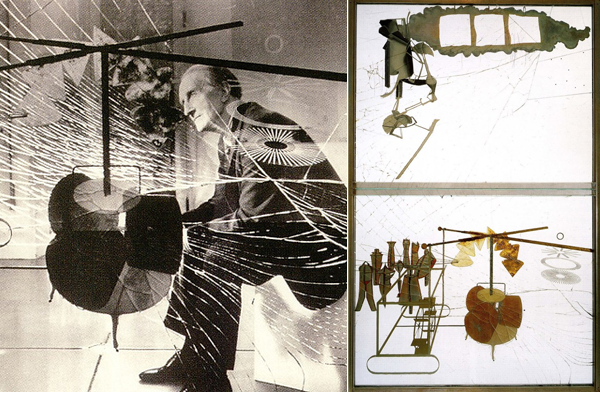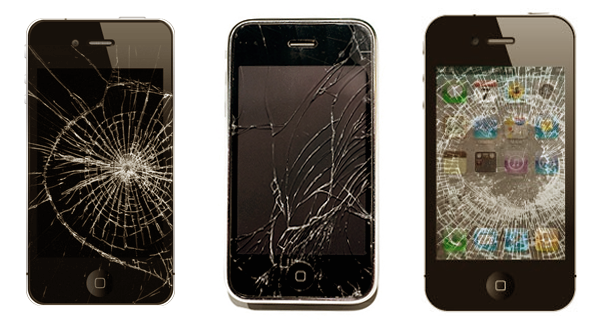Random
Bride Stripped Bare

Between 1915 and 1923, Marcel Duchamp tedious arranged seemingly arbitrary shapes concerning a myth about a bride and her nine bachelors that he would refuse to convey to others. The Bride Stripped Bare by Her Bachelors, Even leaves us with an eerie Avant-garde cartoon embedded between panes of cracked glass which conform to a unique “mechanomorphic” law of physics, whose notes began in 1913, he was to incorporate in The Green Box (1934), a limited edition (of 320) scrap heap compilation of its conception and execution — though let not the word “edition” and the auspices of printing fool you; he produced each one by hand. The cracks in the glass are ostensibly controlled, which may explain why he was both insane and spent eight years to create it. None is this is really meant to make any sense. Duchamp’s self-enthralled solipsisms juggle meaning and nonsense, until the viewer is just left to stare. If there is a God, he too must be a fan: In 1926, the Brooklyn Museum accidentally broke the art piece in transport, making the cracks worse (via the actual laws of physics). Marcel, unfortunately, was not there to repair what he described as a “hilarious picture” in the first place.

There’s a kind of beauty in spending — or at least seeing others do — $200 dollars on a new iPhone, catastrophically dropping it within two weeks, damning the warranty one waived, and resigning to slowly filing off one’s fingerprints over the course of many refreshes, likes, and swipes. They all look the same — on the train or waiting for it — squinting through the cracks at the fragmented semblance of the internet within, letters obscured by the greater refractions under which they reside. Touchscreens employ “capacitive sensing” technology whereby the human body acts as an electrical conductor that channels signals through an electrostatic field to an indium tin oxide (ITO) receptor plate. Unlike “resistive sensing” i.e. pressure sensitive touchscreens, capacitive sensing requires life-like forms i.e. a bare finger or, as this contributor has tested and confirmed, a tangerine. Electrically insulating material like gloves don’t work. In South Korea, during cold winters, people have been known to use small sausages as surrogate fingers while wearing gloves. The past-life of meat, evidently, has an ongoing legacy. That a non-living device can approve if we are living — the latter pensively looking for affirmation in the former — is an inverted sentience which promises to eventually kill us off.
In the meta-fuckhole that is the internet, with the help of Ritalin and graphic design degrees, you can get an assortment of cracked iPhone screensavers for their pristine hosts, the semblance of disaster but a smart smirk, which is a long way from the more earnest fireplace footage public access channels would show on Christmas Eve for the sad and lonely in their apartments (or, the hopeful prophecy of The Scenery Channel in Back to the Future II that displays landscapes on TV as if looking through a window, though Magritte covered most of this ground in The Human Condition (1933), which shows a canvas in front of a window painted as the scene it’s partitioning off). The pedestrian crown, or shield, of a smartphone emits a radius of importance and inhospitality. To see someone playing solitaire, or refreshing their own profile for attention, is a shameful moment. Perhaps the shaving off of our fingerprints — in the name of pinching-in and -out, of “load[ing] more posts,” of swiping through calendar months in a race towards death — is a plea to reset our guilt ridden identities, to become clones of ourselves with a cleaner record.
First ambivalent, then sarcastically resigned (he had abandoned art and was now playing chess), Duchamp sanctioned replicas of The Bride Striped Bare by Her Bachelors, Even for exhibitions at Moderna Museet (Stockholm), Tate Gallery (London), and University of Tokyo’s Komaba Museum. The problem of course, for the eager curators and snooty interns, was exactly how to break the glass exactly. His Dadaist physics turned out to be a bunch of ramblings having little to do with the outward fractal-like grasp of glass finding separation from its tension, the dangerous give of the path of least resistance. If glass is liquid, then shards are mere puddles, but no one has time to wait. It is ironic that the man who tried to kill the concept of the “original” was inadvertently tethered to it by the unique chaos through which such originality would find its irrevocability. I imagine him hovered above the glass with a gentle rubber mallet and tappy chisel, spreading neurons of cuckoo. As for the creepy gang bang allusion in our title, we need not worry for the Bride. She safely hovers above the sausage fest, braced by the very shards which seem to cut her.

“None is this is really meant to make any sense.”
really? does anyone check these articles before they’re thrown up on the site?
anyway, aside from the distracting typos, good points. amazing piece of art, that Bride.
iBride Stripped Bare?
the digression into the technology behind touchscreens was interesting and informative.
oh, i always thought the initial cracks were intentional, perhaps biased by the picture of him with the cracks (what i thought was him in his studio — which would corroborate the intent — but now i see he’s in a museum), not to mention that much of the piece was about “chance procedures.” i didn’t know, but really enjoy the idea of the dust accumulation; morandi was similarly accepting/inviting of dust as slow motion paint. funny, the cover of ‘the age of wire and string’ has a duchampian feel, figure that one out…
nice, i was struggling for a title…
no one checks anything, the camera’s just rolling. it’s like ‘the real world,’ where characters are both judged and loved, and there’s always one gay person and one black person